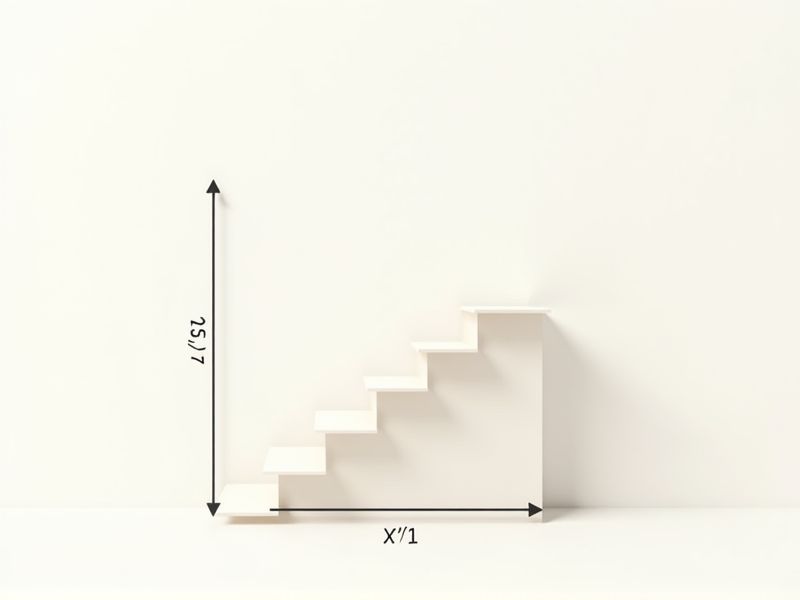
When designing a flight of stairs, certain standard dimensions ensure both safety and comfort. Typically, the height (riser) of each step should be around 7 inches, while the depth (tread) is commonly about 11 inches. For most residential applications, a stair width of 36 inches is recommended, providing enough space for easy passage. Additionally, the total vertical distance a single flight should cover is commonly limited to 12 feet before a landing is required, to prevent fatigue and enhance safety for users.
Rise Height
The standard rise height for stairs typically ranges from 4 to 7 inches, with 7 inches being the maximum recommended by the International Building Code (IBC). This measurement ensures safety and ease of use, as it allows for comfortable ascending and descending. For residential construction, a common rise height is about 6 to 7 inches, balancing functionality with aesthetics. When designing your staircase, maintaining consistent rise heights across all steps helps prevent accidents and improves overall accessibility.
Tread Depth
The standard tread depth for flight stairs is typically between 10 to 11 inches, promoting safety and comfort during use. Compliance with the International Building Code (IBC) is essential, as it mandates that the minimum tread depth be at least 10 inches for residential buildings. Ensuring an appropriate tread depth can reduce the risk of accidents, as shallower treads may lead to missteps. For optimal design, consider incorporating a consistent tread depth throughout your staircase to enhance both functionality and aesthetic appeal.
Total Run
The standard total run for a flight of stairs typically measures 1 foot (12 inches) per step in a residential setting, ensuring that each step provides adequate stability and comfort. For commercial applications, the International Building Code recommends a total run of approximately 11 inches for each tread. When designing a staircase, you're encouraged to maintain a minimum total run of 36 inches for flights of more than 3 steps to ensure safety and accessibility. Properly calculated total runs minimize the risk of falls and enhance the usability of staircases in various environments.
Stair Width
The standard width of a flight of stairs typically ranges from 36 inches (91 cm) to 48 inches (122 cm), ensuring comfort and safety for users. For commercial buildings, a minimum width of 44 inches (112 cm) is often mandated to accommodate higher foot traffic. Wider stairs can significantly enhance accessibility, allowing easier movement for individuals using mobility aids. When designing your stairs, consider that each additional inch can improve overall user experience and safety.
Headroom Clearance
The standard headroom clearance for a flight of stairs typically measures at least 80 inches (2032 mm) to ensure safety and comfort for users. This measurement applies from the nosing of the treads, allowing individuals of varying heights to ascend and descend without obstruction. In residential spaces, compliance with the minimum headroom guideline is essential, as it prevents accidents and enhances accessibility. You should always verify local building codes, as specific regulations may differ based on location and structure type.
Landing Size
The standard landing size for a flight of stairs typically measures 36 inches by 36 inches (91 cm by 91 cm) to ensure safety and accessibility. It provides sufficient space for individuals to maneuver comfortably, especially when carrying items or accommodating multiple users. Compliance with building codes is crucial; for instance, the International Building Code (IBC) mandates landings at the top and bottom of each staircase, with a minimum depth equal to the width of the stairway. Prioritizing an adequate landing size can significantly enhance the safety and usability of your staircase design.
Nosing Projection
The standard nosing projection for flight stairs typically ranges from 0.25 to 1.5 inches, ensuring user safety and comfort during ascent and descent. Proper nosing design features rounded edges that minimize hazards, preventing slips and falls. Building codes often mandate that the depth of the tread should be at least 11 inches, providing adequate space for foot placement and stability. Maintaining these dimensions is crucial for public spaces, where regulations like the International Building Code (IBC) help standardize safety measures across various structures.
Stringer Dimensions
The dimensions of stringers in flight of stairs are critical for ensuring safety and stability, with standard widths typically ranging from 36 to 48 inches. Each stringer usually features a rise of 7 to 8 inches and a tread depth of 10 to 12 inches, aligning with the recommended stair safety guidelines. For residential projects, the stringer material is often plywood or solid wood, with a thickness of at least 1 inch to support weight effectively. Accurate measurements are essential, as even slight deviations can lead to significant safety hazards and discomfort during use.
Baluster Spacing
Baluster spacing on a flight of stairs should adhere to building codes, typically requiring a maximum gap of 4 inches between balusters. This regulation is crucial for safety, preventing children from slipping through and sustaining injuries. Your staircase balusters should also be securely installed, with a recommended height of 36 inches for residential properties to ensure proper support and stability. Regular inspections are advisable to maintain safety and compliance with these standards, ensuring that your stairs remain both functional and visually appealing.
Handrail Height
The standard height for handrails on flights of stairs typically ranges from 34 to 38 inches (86 to 97 centimeters) above the stair nosing. This height ensures that handrails are both accessible and effective for user support. Furthermore, the rail should extend at least 12 inches (30 centimeters) beyond the top and bottom of the stairs for added safety. Ensuring compliance with these measurements enhances safety and promotes ease of use for individuals navigating stairs.
